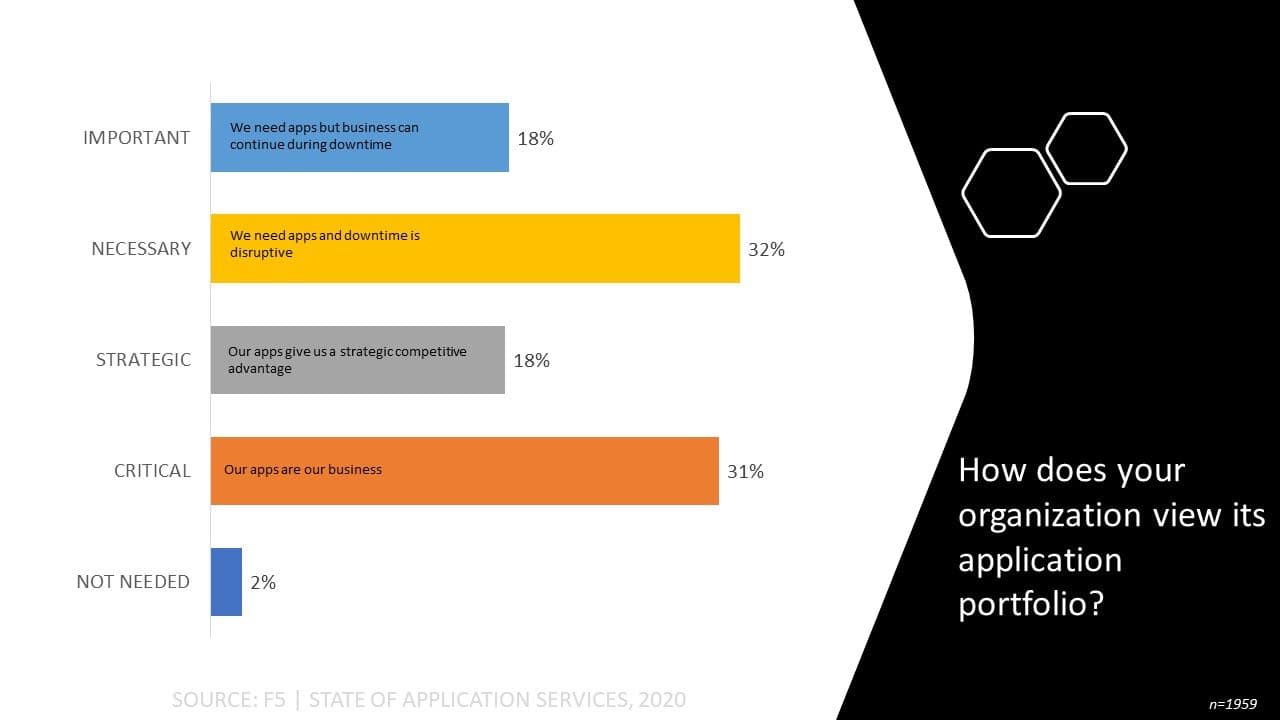When we dig into the state of application services each year, we don't just focus on app services. While that's certainly our primary interest, there are a plethora of trends and technologies that impact app services in general.
Over the years we've watched as new app architectures, automation, and cloud have increasingly had an impact on application services. It's necessitated a shift from delivering app services as software to software coupled to hardware, from virtual machines to the cloud and, more recently, to containers.
Our research tells us that organizations today are incredibly heterogeneous. Not just in their adoption of a multi-cloud strategy but in their application portfolio.
The application services that support today's business must be as diverse as the architectures that comprise their app portfolios. We see the importance of that diversity in the variety of form factors respondents tell us they want for their application services.
In 2020, respondents tell us they want containerized app services. That demand has more than doubled in just two years, growing from 9% in 2018 to 19% in 2020. During the same time, demand from virtual machines has declined from 30% in 2018 to just 16% in 2020. It is clear containers are gaining at the expense of virtual machines.
But those aren't the only way organizations want app services delivered. Network appliance (hardware) remains as popular as virtual machines with 16% of respondents. A healthy 10% prefer app services to be delivered "as a service." Another 6% would like a web or app server plug-in, such as NGINX. And 5% are interested in an application library as a delivery medium, an option that indicates a growing interest in application services from developers and DevOps alike as this form factor requires tight coupling to the application itself.
If that sounds odd, it shouldn't. A healthy 36% of applications today are internally developed. The inclusion of app services as part of the app is an increasing theme in the microservices/container-native landscape. A container-native architecture is inclusive of a specific set of app services without which the app cannot scale. Ingress control and service discovery deployment rates—both on-premises and in the public cloud -are rising fast—right along with the growth of microservices-based apps in the enterprise portfolio.
That portfolio is increasingly important and, for those racing ahead on their digital transformation journey, strategic. We asked respondents how their organization views its app portfolio and were unsurprised to find that most organizations rely on apps and that downtime is disruptive.

Also unsurprising is the connection between apps and digital transformation. As organizations progress toward the final phase of their journey, more organizations begin to consider their apps a strategic competitive advantage.
The view of applications has been shifting for decades, but digital transformation has accelerated that shift. More of the business today is irrevocably entwined with applications than in the past, and this trend will continue as organizations continue to find new ways to work and engage with partners, customers, and employees through applications.
If you haven't gotten your copy of this year's report, you can grab it here.
About the Author

Related Blog Posts

AppViewX + F5: Automating and orchestrating app delivery
As an F5 ADSP Select partner, AppViewX works with F5 to deliver a centralized orchestration solution to manage app services across distributed environments.

Build a quantum-safe backbone for AI with F5 and NetApp
By deploying F5 and NetApp solutions, enterprises can meet the demands of AI workloads, while preparing for a quantum future.

F5 ADSP Partner Program streamlines adoption of F5 platform
The new F5 ADSP Partner Program creates a dynamic ecosystem that drives growth and success for our partners and customers.
F5 NGINX Gateway Fabric is a certified solution for Red Hat OpenShift
F5 collaborates with Red Hat to deliver a solution that combines the high-performance app delivery of F5 NGINX with Red Hat OpenShift’s enterprise Kubernetes capabilities.
F5 Silverline Mitigates Record-Breaking DDoS Attacks
Malicious attacks are increasing in scale and complexity, threatening to overwhelm and breach the internal resources of businesses globally. Often, these attacks combine high-volume traffic with stealthy, low-and-slow, application-targeted attack techniques, powered by either automated botnets or human-driven tools.
Phishing Attacks Soar 220% During COVID-19 Peak as Cybercriminal Opportunism Intensifies
David Warburton, author of the F5 Labs 2020 Phishing and Fraud Report, describes how fraudsters are adapting to the pandemic and maps out the trends ahead in this video, with summary comments.
